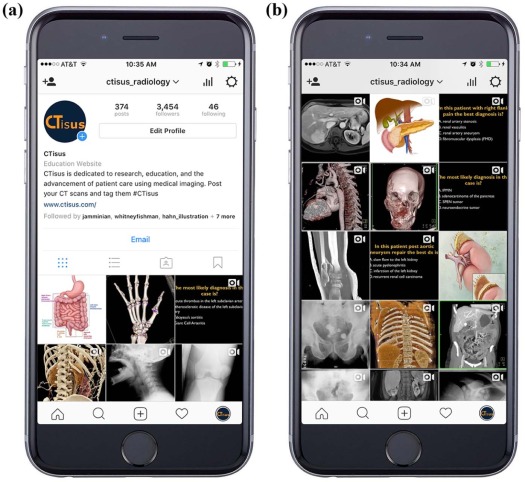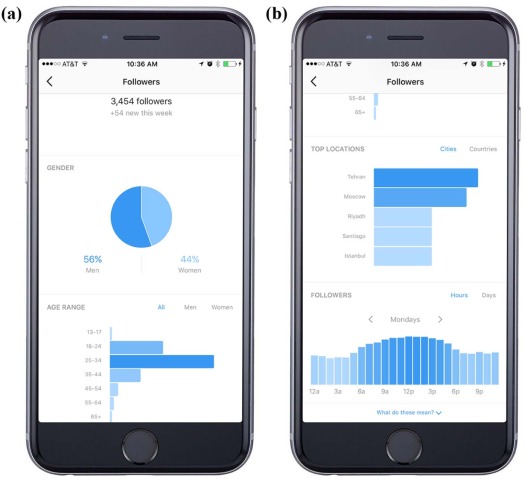Since its inception in 2010, Instagram has rapidly grown into one of the world’s largest social media forums, with over 700 million registered users. In the field of medicine, Instagram has been used for professional development and is also being added to the armamentarium of social media vehicles for education.
Utilization of Instagram for medical education lags behind Facebook and Twitter, as many educators may not recognize the potential role. The purpose of this manuscript is to describe unique features of Instagram that are not found on Facebook and Twitter, with the aim of facilitating use of Instagram for radiology education.
Introduction
The Problem
Since its inception in 2010, Instagram has rapidly grown into one of the world’s largest social media forums, with over 700 million registered users . Kevin Systrom and Mike Krieger founded Instagram with the goal of creating a simple-to-use photo and lifestyle sharing application . However, social media users quickly embraced Instagram as a personal communication platform.
Beyond individual engagement for social interaction, companies such as National Geographic and Forbes use Instagram as a marketing platform . In the field of medicine, Instagram has been used for professional development and is also being added to the armamentarium of social media vehicles for education .
Utilization of Instagram for medical education lags behind Facebook and Twitter, as many educators may not recognize the potential role. A 2015 survey found that the top four social media resources used by educators to communicate with students were Facebook (52%), Twitter (47%), LinkedIn (21%), and Google + (16%), whereas the medical students most commonly used Facebook (100%), YouTube (43%), Twitter (31%), and Instagram (30%) . The highest population of Instagram users are between the ages of 18–29, correlating to the years spent in college and medical school . Instagram is ideally suited for radiology education because the biggest difference between Instagram and other widely used social media tools is its primary content: images. Instagram posts require an image with text as an optional supporting element, whereas other social platforms like, Facebook and Twitter, allow text-only posts. Instagram also has the potential to reach across professional roles (student, resident, technologist, and physicians) and to inspire more medical students to pursue radiology as a career by reaching them early in their premedical and medical school education. The application, however, is not the most intuitive for the inexperienced user. The purpose of this manuscript is to describe features unique to Instagram that are not found on Facebook and Twitter, with the aim of facilitating use of Instagram for radiology education.
What We Did
CTisus.com is a radiology teaching website that has been actively using Instagram ( Fig 1 ) as an educational tool since July 2016, enabling experience-based guidance on how to use the resource. One major distinction from Facebook and Twitter is that Instagram is a smartphone- and a tablet-based program, not designed for content building on a computer. Images and videos are easily viewed on a desktop or a laptop computer in news feed format, but creating and building a library is performed on handheld devices.
Get Radiology Tree app to read full this article<
Get Radiology Tree app to read full this article<
Get Radiology Tree app to read full this article<
Theme
Get Radiology Tree app to read full this article<
Regularity
Get Radiology Tree app to read full this article<
Variety
Get Radiology Tree app to read full this article<
Hashtags
Get Radiology Tree app to read full this article<
Get Radiology Tree app to read full this article<
Pitfalls
Get Radiology Tree app to read full this article<
Outcome
Get Radiology Tree app to read full this article<
Get Radiology Tree app to read full this article<
Get Radiology Tree app to read full this article<
Get Radiology Tree app to read full this article<
References
1. Constine J.: Instagram’s growth speeds up as it hits 700 million users. Tech Crunch; Available at https://www.inc.com/30under30/2011/index.html
2. Lagoria-Chafkin C.: Kevin Systrom and Mike Krieger, founders of Instagram. Inc.com.; Available at https://www.inc.com/30under30/2011/profile-kevin-systrom-mike-krieger-founders-instagram.html
3. National Geographic Instagram. Available at https://www.instagram.com/natgeo/
4. Patel N.: How to use Instagram to build your brand. Forbes; Available at https://www.forbes.com/sites/brianrashid/2017/06/20/how-to-use-instagram-to-build-your-brand/2/#5466604817d1
5. Alsobayel H.: Use of social media for professional development by health care professionals: a cross-sectional web-based survey. JMIR Med Educ 2016; 2: pp. e15.
6. El Bialy S., Jalali A.: Go where the students are: a comparison of the use of social networking sites between medical students and medical educators. JMIR Med Educ 2015; 1: pp. e7.
7. Ranginwala S.A., Merrow A.C., Towbin A.J.: Using Instagram to deliver radiology education. Siim.org. Siim. Web2017. Available at http://siim.org/?page=15ab_using_instagram
8. Timothy P.G., Jeffrey B., Kaitlyn L., et. al.: Delivery of educational content via Instagram(®). Med Educ 2016; 50: pp. 575-576.
9. Pew Research Center : Internet and technology. Social media update. Available at http://www.pewinternet.org/2016/11/11/social-media-update-2016/
10. Patel N.: How frequently you should post on social media according to the pros. Available at https://www.forbes.com/sites/neilpatel/2016/09/12/how-frequently-you-should-post-on-social-media-according-to-the-pros/2/#10835712100f

